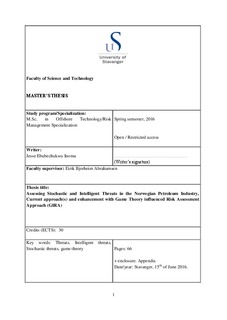| dc.contributor.author | Inoma, Jesse | |
| dc.date.accessioned | 2016-10-03T10:55:06Z | |
| dc.date.available | 2016-10-03T10:55:06Z | |
| dc.date.issued | 2016-06-14 | |
| dc.identifier.uri | http://hdl.handle.net/11250/2412519 | |
| dc.description | Master's thesis in Risk management | nb_NO |
| dc.description.abstract | In the Norwegian petroleum industry quantitative risk assessments QRA’s are carried out to assess risk as well as for accounting for uncertainties given the strength of background knowledge available to the assessors. The NORSOK Z-013 standard is used as a guideline for doing this in practice. This thesis focuses on enhancing the current quantitative risk assessment approach being used in the industry by combining it with the game theory. It is from this synergy that a new approach termed ‘GIRA’ game theory influenced risk assessment was suggested in this research work. As the boundaries for innovation are pushed in the industry, likewise are the threats from petroleum activities increasing. These threats can be stochastic or intelligent in nature, because of this increase in risk there needs to be improvement in the methodology to unravel these threats. The GIRA approach provides the necessary robustness to combat the increasing complex nature of threats facing the industry. Previous research has been carried out in this field by notable researcher’s such as Vicki Bier and Terje Aven. Vicki Bier suggests a strategy for allocating resources efficiently in combating intelligent threats. Also, the research work carried out by Prof. Aven in the correct use of QRA’s in the industry is exemplary. However, there exist some gaps in these researches, the work done by Bier is a justification for investment to combat intelligent threats such as terrorism and does not cover much about stochastic threats. As for the research work done by Prof Aven, with the increase in the threat level exposure in the industry there is need to see the limitations of a QRA, hence why it should be improved upon. The GIRA approach is a strategy that will be able to address the limitations of the QRA because of the two-step analyses process, first by a QRA then analysis of the QRA result with the GIRA approach. A case study about an ignited process leak was carried out to show how the GIRA approach will be used in practice.
It is believed that by applying the GIRA approach extensively in the Norwegian petroleum industry, a more robust analysis will be available to present a complete picture of risk from intelligent and stochastic threats to decision makers. | nb_NO |
| dc.language.iso | eng | nb_NO |
| dc.publisher | University of Stavanger, Norway | nb_NO |
| dc.relation.ispartofseries | Masteroppgave/UIS-TN-IØRP/2016; | |
| dc.rights | Navngivelse-IngenBearbeidelse 3.0 Norge | * |
| dc.rights.uri | http://creativecommons.org/licenses/by-nd/3.0/no/ | * |
| dc.subject | risikostyring | nb_NO |
| dc.subject | risk management | nb_NO |
| dc.subject | game theory | nb_NO |
| dc.subject | intelligent threats | nb_NO |
| dc.subject | stochastic threats | nb_NO |
| dc.title | Assessing Stochastic and Intelligent Threats in the Norwegian Petroleum Industry, Current Approach(s) and Enhancement with Game Theory influenced Risk Assessment Approach (GIRA) | nb_NO |
| dc.type | Master thesis | nb_NO |
| dc.subject.nsi | VDP::Technology: 500::Marine technology: 580::Offshore technology: 581 | nb_NO |

